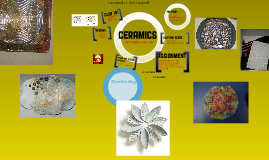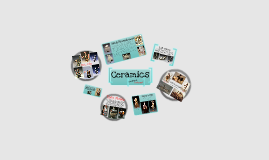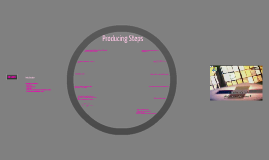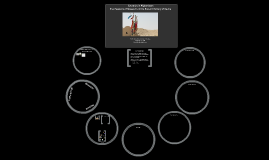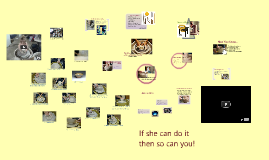Ceramics
Transcript: CERAMICS Project by Louis DiGiacomo & Michael Roca What is a ‘ceramic’? Ceramic materials are inorganic, nonmetallic materials. Most ceramics are compounds between metallic and nonmetallic elements for which the interatomic bonds are either totally ionic or predominantly ionic but having some covalent character. Most common ceramics are crystalline, the definition of ceramic is often restricted to inorganic crystalline materials. Traditional ceramic raw materials include clay minerals such as kaolinite, whereas more recent materials include aluminium oxide. Ceramics generally can withstand very high temperatures, such as temperatures that range from 1,000 °C to 1,600 °C (1,800 °F to 3,000 °F). The term ceramic comes from the Greek word keramikos, which means burnt stuff, indicating that desirable properties of these materials are normally achieved through a high-temperature heat treatment process called firing. The earliest ceramics were pottery objects made from clay, either by itself or mixed with other materials, hardened in fire. Later ceramics were glazed and fired to create a colored, smooth surface. What are the properties that make ceramics so useful? Most ceramics consist of one or more varieties of a metal oxide. A metal oxide is a compound of a metal and oxygen—when the metal is bonded to the oxygen its properties can change dramatically. For instance, when it is bonded with oxygen, the metal aluminum, which is valued for its flexibility and capacity to conduct electricity and heat, becomes a hard, brittle, electrically and thermally insulating ceramic known as alumina. How are Ceramics made? Firing is the process by which ceramics have traditionally been made. During firing, there is reaction between the mixture of inorganic elements and compounds at temperatures as high as 2000°F. Just as in ancient times, today's pottery is made by digging clay from the ground, mixing it with water to make it flexible, shaping it on a wheel or in a mold, and then firing it in a kiln The latest industrial ceramics sometimes demand more advanced production processes. Extremely tough ceramics made of silicon nitride are made by a method called reaction bonding. This involves forming silicon powder into the desired shape then heating it with nitrogen gas. Because the silicon powder already occupies the same volume as the finished product, grains of silicon nitride can form only by fusing together tightly. Barium titanate BaTiO3 Properties Molecular formula BaTiO3 Molar mass 233.192 g/mol Appearance white crystals Density 6.02 g/cm3, solid Melting point 1625 °C Solubility in water insoluble Solubility slightly soluble in dilute mineral acids; dissolves in concentrated sulfuric acid and hydrofluoric acid The best-known ceramics are pottery, glass, brick, porcelain, and cement. Ceramics are generally thought of as inorganic and nonmetallic solids with a range of useful properties, including very high hardness and strength, extremely high melting points, and good electrical and thermal insulation. Crystalline ceramic materials are not amenable to a great range of processing. Methods for dealing with them tend to fall into one of two categories – either make the ceramic in the desired shape, or by "forming" powders into the desired shape, and then sintering to form a solid body. Ceramic forming techniques include shaping by hand or throwing, slip casting, tape casting, injection molding, dry pressing, and other variations. Noncrystalline ceramics, being glasses, tend to be formed from melts. The glass is shaped when either fully molten, by casting, or when in a state of toffee-like viscosity, by methods such as blowing to a mold. If later heat treatments cause this glass to become partly crystalline, the resulting material is known as a glass-ceramic Over the last several decades, bioceramics have helped improve the quality of life for millions of people. These specially designed materials—polycrystalline aluminum oxide, hydroxyapatite (a mineral of calcium phosphate that is also the major component of vertebrate bone), partially stabilized zirconium oxide, bioactive glass or glass-ceramics, and polyethylene-hydroxyapatite composites—have been successfully used for the repair, reconstruction, and replacement of diseased or damaged parts of the body, especially bone. For instance, aluminum oxide has been used in orthopedic surgery for more than 20 years as the joint surface in total hip prostheses because of its exceptionally low coefficient of friction and minimal wear rates. Ceramics are familiar to us as materials that can be formed into objects that have a range of useful properties: not conducting electricity, resisting corrosion, and being hard, durable, and waterproof. Crystalline Ceramics . What are Ceramics used for? What do all Ceramics have in common? The Origin of Ceramics Noncrystalline Ceramics BIOCERAMICS






